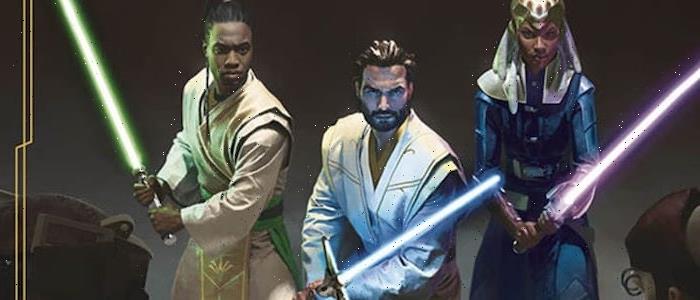
This post contains minor spoilers.
Written by Cavan Scott, Star Wars: The High Republic – The Rising Storm is the latest major novel in this first wave of stories coming from the High Republic era of Star Wars. Taking place approximately a year after Charles Soule’s Light of the Jedi, the Nihil have been biding their time and laying low as the Republic and the Jedi grow complacent. In order to show off the strength and culture of the Republic to a region of the galaxy that might need other inducements to join the galactic government, Chancellor Soh has organized a Republic Fair on the planet of Valo. This planet will play host to dozens of cultures on islands representing each of them, offering a theme park-like experience for every visitor, getting to have a taste of the most important areas of the Republic.
That all comes crashing down when the Nihil, feeling forced into action, attack the Fair in an attempt to show their dominance by killing the Chancellor and making the entire galaxy feel unsafe.
The Jedi are able to repel the attack and save the Chancellor, but there is much more at work behind the scenes than meets the eye and many more mysteries and secrets to be revealed.
The book is a fascinating look at what it might be like to have an EPCOT-style World’s Fair in the Star Wars galaxy, and it almost begs you to be a nerd for Disney history.
The entire Republic Fair feels consistent with that Disney in Star Wars-theme and it fits so well with this era of the Republic. Baked into the World’s Fairs of our own human history is a sense of optimism for the future, a genuine hope to look future. It’s something Brad Bird and Damon Lindelof tried exploring in their interesting but forgettable film, Tomorrowland. Walt Disney was wholly invested in that message of hope and vision of the future that World’s Fairs brought. The 1964 World’s Fair was something Walt Disney took on as a personal project, creating attractions we still enjoy to this day, including Great Moments With Mr. Lincoln, it’s a small world, and The Carousel of Progress.
In fact, the United in Song exhibit featured at the Republic Fair is a pretty obvious reference to it’s a Small World and its earworm of a soundtrack written by the Sherman Brothers. The ride was brought to Disneyland by Walt Disney after the fair.
It’s a perfect lens through which to view this moment of the Republic. It’s a more optimistic time, but trouble brews on the horizon. If the classic trilogy is a look at our world through the lens of the anti-war ‘70s and ‘80s and the prequels are a look at our world through the art deco greatness of the ’20s before descending into the war of the ‘40s, then this is a look at the galaxy in its optimistic space age of the ‘50s and ‘60s just before it crumbles, something we haven’t really seen in Star Wars before.
The characters are drawn particularly well in this book as well. The standouts are the complicated Jedi Elzar Mann, a charming rogue of a Jedi, struggling with his place in the order and his womanizing, and Bell Zettifar, the young padawan who lost his master, Loden Greatstorm, in the previous novel.
Characters from other prime pieces of High Republic fiction appear as well, coming in and out of the story as appropriate. If you’re interested in knowing which of the latest High Republic releases you should read first, though, I’d choose this over Race to Crashpoint Tower, written by Daniel Jose Older. This sets up the events, and the characters from that book feature here, but their story is ultimately told both ways. This one sets up understanding of events that they hang the other on, so it makes sense to read this one first.
A couple of interesting tidbits to watch out for. First, the book opens on Ashla, the moon of Tython. Tython was the site of one of the first Jedi temples and featured prominently in the second season of The Mandalorian. That was the site of Grogu’s abduction at the hands of Moff Gideon. The moon, however, is named Ashla. Ashla was an original reference to the light side of the Force from George Lucas’s earliest ideas of the concept. It was also what the Lasat people called the concept of the Force in Star Wars Rebels. Interestingly enough, that was a working name for Anakin Skywalker’s padawan as well, before they settled on Ahsoka Tano.
Another character that makes a cameo appearance is Jedi Master Terra Sinube on the planet Derra. He was the aging Jedi in The Clone Wars that acted as Takashi Shimura to Ahsoka’s Toshiro Mifune in the Clone Wars remake of Kurosawa’s Stray Dog called “Lightsaber Lost.” Seeing him a couple of hundred years prior in his prime rather than a more frail senior citizen is a treat. He’s a fascinating character and I hope we see more of him.
Through this book, Scott writes an adventure that reminds me almost of ‘70s disaster cinema. There are elements that feel like The Poseidon Adventure mixed with the pulp adventure Star Wars is known for, leaving you with a breathtaking feeling once the action kicks off. But the ending of this book will leave you feeling uncomfortable. There’s definitely an irony here at work about hope and loss and it’s going to punch many in the gut. You really won’t want to put it down once the attack on the Fair begins. I know I didn’t.
Star Wars: The High Republic – The Rising Storm is available now wherever books are sold.
Source: Read Full Article
